无无限互联iOS开发第三框架之导航栏篇XHYScrollingNavBarVC 和 NavigationMenu-master集成。
- 格式:doc
- 大小:115.50 KB
- 文档页数:3
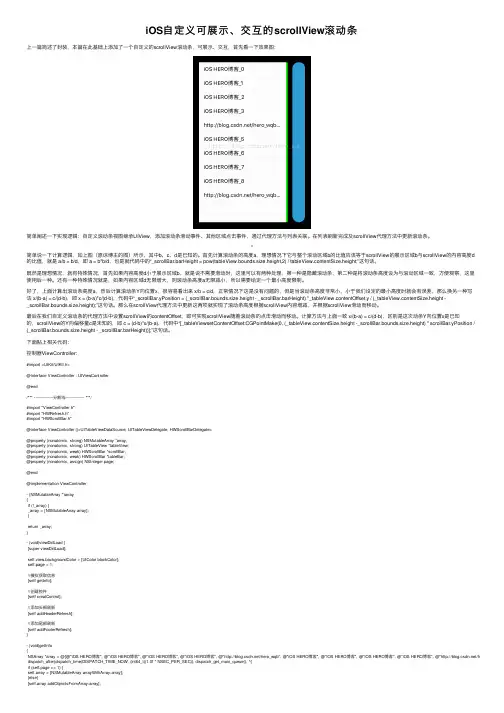
iOS⾃定义可展⽰、交互的scrollView滚动条上⼀篇简述了封装,本篇在此基础上添加了⼀个⾃定义的scrollView滚动条,可展⽰、交互,⾸先看⼀下效果图:简单阐述⼀下实现逻辑:⾃定义滚动条视图继承UIView,添加滚动条滑动事件、其他区域点击事件,通过代理⽅法与列表关联。
在列表刷新完成及scrollView代理⽅法中更新滚动条。
简单说⼀下计算逻辑,如上图(原谅博主的图)所⽰,其中b、c、d是已知的。
⾸先计算滚动条的⾼度a,理想情况下它与整个滚动区域b的⽐值应该等于scrollView的展⽰区域b与scrollView的内容⾼度d的⽐值,就是 a/b = b/d,即 a = b*b/d,也是就代码中的“_scrollBar.barHeight = pow(tableView.bounds.size.height,2) / tableView.contentSize.height;”这句话。
既然是理想情况,就有特殊情况,⾸先如果内容⾼度d⼩于展⽰区域b,就是说不需要滑动时,这⾥可以有两种处理,第⼀种是隐藏滚动条,第⼆种是将滚动条⾼度设为与滚动区域⼀致,⽅便观察,这⾥使⽤后⼀种。
还有⼀种特殊情况就是,如果内容区域d⽆限增⼤,则滚动条⾼度a⽆限减⼩,所以需要给定⼀个最⼩⾼度限制。
好了,上⾯计算出滚动条⾼度a,然后计算滚动条Y向位置x,很容易看出来 x/b = c/d,正常情况下这是没有问题的,但是当滚动条⾼度⾮常⼩,⼩于我们设定的最⼩⾼度时就会有误差,那么换另⼀种写法 x/(b-a) = c/(d-b),即 x = (b-a)*c/(d-b),代码中“_scrollBar.yPosition = (_scrollBar.bounds.size.height - _scrollBar.barHeight) *_tableView.contentOffset.y / (_tableView.contentSize.height -_scrollBar.bounds.size.height);”这句话。
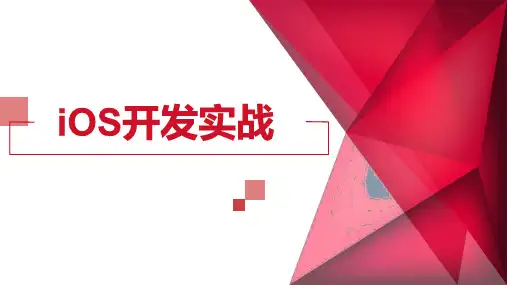
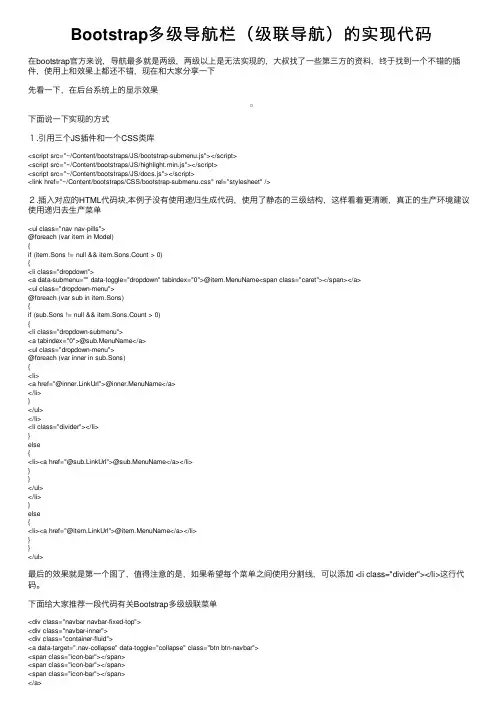
Bootstrap多级导航栏(级联导航)的实现代码在bootstrap官⽅来说,导航最多就是两级,两级以上是⽆法实现的,⼤叔找了⼀些第三⽅的资料,终于找到⼀个不错的插件,使⽤上和效果上都还不错,现在和⼤家分享⼀下先看⼀下,在后台系统上的显⽰效果下⾯说⼀下实现的⽅式1.引⽤三个JS插件和⼀个CSS类库<script src="~/Content/bootstraps/JS/bootstrap-submenu.js"></script><script src="~/Content/bootstraps/JS/highlight.min.js"></script><script src="~/Content/bootstraps/JS/docs.js"></script><link href="~/Content/bootstraps/CSS/bootstrap-submenu.css" rel="stylesheet" />2.插⼊对应的HTML代码块,本例⼦没有使⽤递归⽣成代码,使⽤了静态的三级结构,这样看着更清晰,真正的⽣产环境建议使⽤递归去⽣产菜单<ul class="nav nav-pills">@foreach (var item in Model){if (item.Sons != null && item.Sons.Count > 0){<li class="dropdown"><a data-submenu="" data-toggle="dropdown" tabindex="0">@item.MenuName<span class="caret"></span></a><ul class="dropdown-menu">@foreach (var sub in item.Sons){if (sub.Sons != null && item.Sons.Count > 0){<li class="dropdown-submenu"><a tabindex="0">@sub.MenuName</a><ul class="dropdown-menu">@foreach (var inner in sub.Sons){<li><a href="@inner.LinkUrl">@inner.MenuName</a></li>}</ul></li><li class="divider"></li>}else{<li><a href="@sub.LinkUrl">@sub.MenuName</a></li>}}</ul></li>}else{<li><a href="@item.LinkUrl">@item.MenuName</a></li>}}</ul>最后的效果就是第⼀个图了,值得注意的是,如果希望每个菜单之间使⽤分割线,可以添加 <li class="divider"></li>这⾏代码。
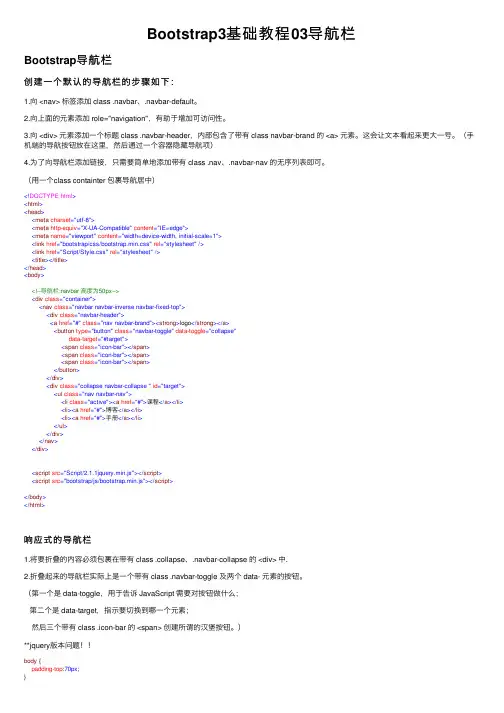
Bootstrap3基础教程03导航栏Bootstrap导航栏创建⼀个默认的导航栏的步骤如下:1.向 <nav> 标签添加 class .navbar、.navbar-default。
2.向上⾯的元素添加 role="navigation",有助于增加可访问性。
3.向 <div> 元素添加⼀个标题 class .navbar-header,内部包含了带有 class navbar-brand 的 <a> 元素。
这会让⽂本看起来更⼤⼀号。
(⼿机端的导航按钮放在这⾥,然后通过⼀个容器隐藏导航项)4.为了向导航栏添加链接,只需要简单地添加带有 class .nav、.navbar-nav 的⽆序列表即可。
(⽤⼀个class containter 包裹导航居中)<!DOCTYPE html><html><head><meta charset="utf-8"><meta http-equiv="X-UA-Compatible" content="IE=edge"><meta name="viewport" content="width=device-width, initial-scale=1"><link href="bootstrap/css/bootstrap.min.css" rel="stylesheet"/><link href="Script/Style.css" rel="stylesheet"/><title></title></head><body><!--导航栏:navbar ⾼度为50px--><div class="container"><nav class="navbar navbar-inverse navbar-fixed-top"><div class="navbar-header"><a href="#" class="nav navbar-brand"><strong>logo</strong></a><button type="button" class="navbar-toggle" data-toggle="collapse"data-target="#target"><span class="icon-bar"></span><span class="icon-bar"></span><span class="icon-bar"></span></button></div><div class="collapse navbar-collapse " id="target"><ul class="nav navbar-nav"><li class="active"><a href="#">课程</a></li><li><a href="#">博客</a></li><li><a href="#">⼿册</a></li></ul></div></nav></div><script src="Script/2.1.1jquery.min.js"></script><script src="bootstrap/js/bootstrap.min.js"></script></body></html>响应式的导航栏1.将要折叠的内容必须包裹在带有 class .collapse、.navbar-collapse 的 <div> 中.2.折叠起来的导航栏实际上是⼀个带有 class .navbar-toggle 及两个 data- 元素的按钮。
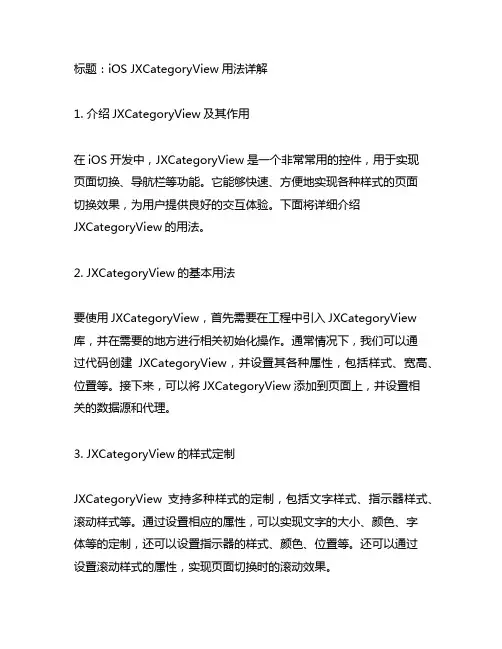
标题:iOS JXCategoryView用法详解1. 介绍JXCategoryView及其作用在iOS开发中,JXCategoryView是一个非常常用的控件,用于实现页面切换、导航栏等功能。
它能够快速、方便地实现各种样式的页面切换效果,为用户提供良好的交互体验。
下面将详细介绍JXCategoryView的用法。
2. JXCategoryView的基本用法要使用JXCategoryView,首先需要在工程中引入JXCategoryView 库,并在需要的地方进行相关初始化操作。
通常情况下,我们可以通过代码创建JXCategoryView,并设置其各种属性,包括样式、宽高、位置等。
接下来,可以将JXCategoryView添加到页面上,并设置相关的数据源和代理。
3. JXCategoryView的样式定制JXCategoryView支持多种样式的定制,包括文字样式、指示器样式、滚动样式等。
通过设置相应的属性,可以实现文字的大小、颜色、字体等的定制,还可以设置指示器的样式、颜色、位置等。
还可以通过设置滚动样式的属性,实现页面切换时的滚动效果。
4. JXCategoryView的数据源和代理在使用JXCategoryView时,通常需要设置其数据源和代理。
数据源用于提供JXCategoryView所需的数据,包括标题、图片、样式等。
代理则用于监听JXCategoryView的各种事件,包括页面切换、点击事件等。
通过设置数据源和代理,可以实现更加灵活和个性化的功能。
5. JXCategoryView的进阶用法除了基本的使用方法,JXCategoryView还支持一些进阶的用法。
可以通过自定义JXCategoryView的子类,实现更加个性化的样式和功能。
还可以结合其他控件,如UIScrollView、UICollectionView等,实现更加复杂的页面切换效果。
通过进阶的用法,可以实现更加丰富和独特的功能。
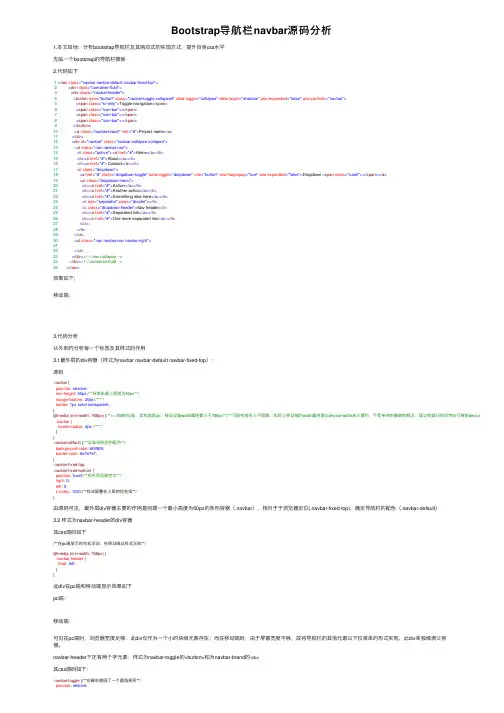
Bootstrap导航栏navbar源码分析1.本⽂⽬地:分析bootstrap导航栏及其响应式的实现⽅式,提升⾃⾝css⽔平先贴⼀个bootstrap的导航栏模板2.代码如下1<nav class="navbar navbar-default navbar-fixed-top">2<div class="container-fluid">3<div class="navbar-header">4<button type="button" class="navbar-toggle collapsed" data-toggle="collapse" data-target="#navbar" aria-expanded="false" aria-controls="navbar">5<span class="sr-only">Toggle navigation</span>6<span class="icon-bar"></span>7<span class="icon-bar"></span>8<span class="icon-bar"></span>9</button>10<a class="navbar-brand" href="#">Project name</a>11</div>12<div id="navbar" class="navbar-collapse collapse">13<ul class="nav navbar-nav">14<li class="active"><a href="#">Home</a></li>15<li><a href="#">About</a></li>16<li><a href="#">Contact</a></li>17<li class="dropdown">18<a href="#" class="dropdown-toggle" data-toggle="dropdown" role="button" aria-haspopup="true" aria-expanded="false">Dropdown <span class="caret"></span></a>19<ul class="dropdown-menu">20<li><a href="#">Action</a></li>21<li><a href="#">Another action</a></li>22<li><a href="#">Something else here</a></li>23<li role="separator" class="divider"></li>24<li class="dropdown-header">Nav header</li>25<li><a href="#">Separated link</a></li>26<li><a href="#">One more separated link</a></li>27</ul>28</li>29</ul>30<ul class="nav navbar-nav navbar-right">3132</ul>33</div><!--/.nav-collapse -->34</div><!--/.container-fluld -->35</nav>效果如下;移动端:3.代码分析从外到内分析每⼀个标签及其样式的作⽤3.1最外层的div容器(样式为navbar navbar-default navbar-fixed-top):源码.navbar {position: relative;min-height: 50px;/**导航条最⼩宽度为50px**/margin-bottom: 20px;/****/border: 1px solid transparent;}@media (min-width: 768px) {/**>=768的设备,其实就是pc,移动设备width属性都⼩于768px**//**可能有很多⼈不理解,实际上移动端的width属性是以device-width来计量的,不是单纯的像数的概念,建议有疑问的同学⾃⾏搜索device-width关键字 .navbar {border-radius: 4px;/****/}}.navbar-default {/**设备导航栏的配⾊**/background-color: #f8f8f8;border-color: #e7e7e7;}.navbar-fixed-top,.navbar-fixed-bottom {position: fixed;/**相对浏览器定位**/right: 0;left: 0;z-index: 1030;/**样式层叠在上层的优先级**/}由源码可见,最外层div容器主要的作⽤是创建⼀个最⼩⾼度为50px的条形容器(.navbar),相对于于浏览器定位(.navbar-fixed-top),确定导航栏的配⾊(.navbar-default)3.2 样式为navbar-header的div容器其css源码如下/**在pc端显⽰时向右浮动,在移动端此样式⽆效**/@media (min-width: 768px) {.navbar-header {float: left;}}此div在pc端和移动端显⽰效果如下pc端:移动端:可见在pc端时,浏览器宽度⾜够,此div仅作为⼀个⼩的块级元素存在;⽽在移动端时,由于屏幕宽度不够,故将导航栏的其他元素以下拉菜单的形式实现,此div单独填满⽗容器。
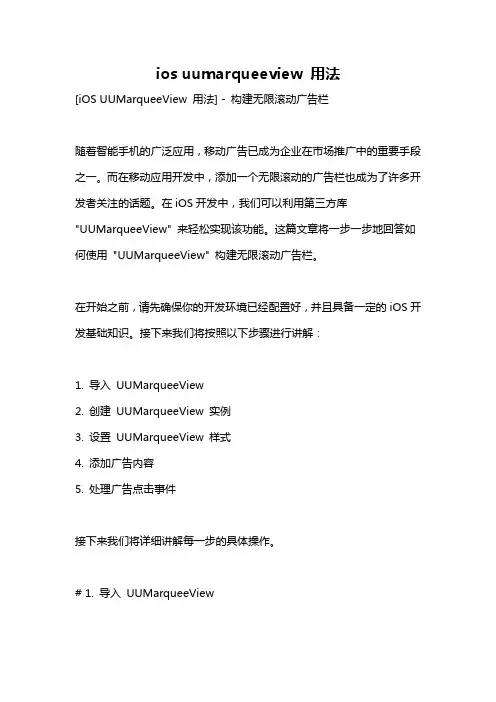
ios uumarqueeview 用法[iOS UUMarqueeView 用法] - 构建无限滚动广告栏随着智能手机的广泛应用,移动广告已成为企业在市场推广中的重要手段之一。
而在移动应用开发中,添加一个无限滚动的广告栏也成为了许多开发者关注的话题。
在iOS开发中,我们可以利用第三方库"UUMarqueeView" 来轻松实现该功能。
这篇文章将一步一步地回答如何使用"UUMarqueeView" 构建无限滚动广告栏。
在开始之前,请先确保你的开发环境已经配置好,并且具备一定的iOS开发基础知识。
接下来我们将按照以下步骤进行讲解:1. 导入UUMarqueeView2. 创建UUMarqueeView 实例3. 设置UUMarqueeView 样式4. 添加广告内容5. 处理广告点击事件接下来我们将详细讲解每一步的具体操作。
# 1. 导入UUMarqueeView首先,我们需要在项目中导入UUMarqueeView。
你可以通过Cocoapods 进行安装,只需在你的`Podfile` 文件中添加以下代码:pod 'UUMarqueeView'然后在终端中执行命令`pod install` 进行安装。
或者,你也可以手动下载UUMarqueeView 的源代码,并将其拖拽到你的项目中。
# 2. 创建UUMarqueeView 实例在导入UUMarqueeView 之后,我们需要创建一个`UUMarqueeView` 的实例,用于承载我们的广告内容。
可以在ViewController 的`viewDidLoad` 方法中添加以下代码:swiftimport UUMarqueeViewclass ViewController: UIViewController {var marqueeView: UUMarqueeView!override func viewDidLoad() {super.viewDidLoad()marqueeView = UUMarqueeView(frame: CGRect(x: 0, y: 100, width: view.frame.width, height: 50))self.view.addSubview(marqueeView)}}上述代码中,我们在`viewDidLoad` 方法中创建了一个`marqueeView` 实例,并将其添加到ViewController 的视图中。
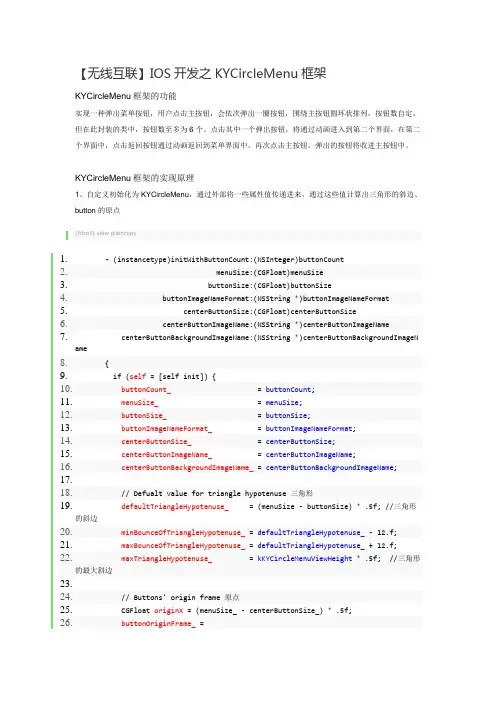
【无线互联】IOS开发之KYCircleMenu框架KYCircleMenu框架的功能实现一种弹出菜单按钮,用户点击主按钮,会依次弹出一圈按钮,围绕主按钮圆环状排列,按钮数自定,但在此封装的类中,按钮数至多为6个。
点击其中一个弹出按钮,将通过动画进入到第二个界面,在第二个界面中,点击返回按钮通过动画返回到菜单界面中。
再次点击主按钮,弹出的按钮将收进主按钮中。
KYCircleMenu框架的实现原理1、自定义初始化为KYCircleMenu,通过外部将一些属性值传递进来,通过这些值计算出三角形的斜边、button的原点[html]view plaincopy1.- (instancetype)initWithButtonCount:(NSInteger)buttonCount2. menuSize:(CGFloat)menuSize3. buttonSize:(CGFloat)buttonSize4. buttonImageNameFormat:(NSString *)buttonImageNameFormat5. centerButtonSize:(CGFloat)centerButtonSize6. centerButtonImageName:(NSString *)centerButtonImageName7. centerButtonBackgroundImageName:(NSString *)centerButtonBackgroundImageName8.{9. if (self = [self init]) {10.buttonCount_ = buttonCount;11.menuSize_ = menuSize;12.buttonSize_ = buttonSize;13.buttonImageNameFormat_ = buttonImageNameFormat;14.centerButtonSize_ = centerButtonSize;15.centerButtonImageName_ = centerButtonImageName;16.centerButtonBackgroundImageName_ = centerButtonBackgroundImageName;17.18. // Defualt value for triangle hypotenuse 三角形19.defaultTriangleHypotenuse_ = (menuSize - buttonSize) * .5f; //三角形的斜边20.minBounceOfTriangleHypotenuse_ = defaultTriangleHypotenuse_ - 12.f;21.maxBounceOfTriangleHypotenuse_ = defaultTriangleHypotenuse_ + 12.f;22.maxTriangleHypotenuse_ = kKYCircleMenuViewHeight * .5f; //三角形的最大斜边23.24. // Buttons' origin frame 原点25. CGFloat originX = (menuSize_ - centerButtonSize_) * .5f;26.buttonOriginFrame_ =27. (CGRect){{originX, originX}, {centerButtonSize_, centerButtonSize_}};28. }29. return self;30.}2、在加载视图(loadView)中,计算出self.view的frame; 在计算self.view 的高度时,还判断了当前控制器是否隐藏了导航栏,如果隐藏了,则此视图的高度就为整个屏幕的高度,否则,就要减去导航栏的高度[html]view plaincopy1.- (void)loadView2.{3. CGFloat viewHeight =4. (self.navigationController.isNavigationBarHidden5. ? kKYCircleMenuViewHeight : kKYCircleMenuViewHeight - kKYCircleMenuNavigationBarHeight);6. CGRect frame = CGRectMake(0.f, 0.f, kKYCircleMenuViewWidth, viewHeight);7. UIView * view = [[UIView alloc] initWithFrame:frame];8.self.view = view;9.}3、在viewDidLoad方法中,作了以下操作<1>设置menu_视图,这个用来装载button菜单按钮的<2>根据buttonCount_外部传进来的值来确定button菜单按钮的个数,来创建button,并将这些button全都叠放在menu_视图的中间<3>并创建了中间的主按钮centerButton,用来控制是否显示菜单按钮,将centerButton添加到了当前视图的正中间,与菜单按钮的原始frame重叠<4>监听了菜单按钮关闭的通知[html]view plaincopy1.- (void)viewDidLoad2.{3. [super viewDidLoad];4.5. // Constants6. CGFloat viewHeight = CGRectGetHeight(self.view.frame);7. CGFloat viewWidth = CGRectGetWidth(self.view.frame);8.9. //菜单视图的frama10. CGRect centerMenuFrame =11.CGRectMake((viewWidth - menuSize_) * .5f, (viewHeight - menuSize_) * .5f, menuSize_, menuSize_);12. //menu_指菜单视图13.menu_ = [[UIView alloc] initWithFrame:centerMenuFrame];14. [menu_ setAlpha:0.f];15. [self.view addSubview:menu_];16.17. // Add buttons to |ballMenu_|, set it's origin frame to center18. //buttonCount_ 周围菜单按钮的个数19. NSString * imageName = nil;20. for (int i = 1; i <= buttonCount_; ++i) {21. UIButton * button = [[UIButton alloc] initWithFrame:buttonOriginFrame_];22. [button setOpaque:NO]; //NO 设置控件透明, YES 设置控件不透明,默认为YES23. [button setTag:i];24.imageName = [NSString stringWithFormat:self.buttonImageNameFormat, button.tag];25. [button setImage:[UIImage imageNamed:imageName]26. forState:UIControlStateNormal];27. [button addTarget:self action:@selector(runButtonActions:) forControlEvents:UIControlEventTouchUpInside];28. [self.menu addSubview:button];29. }30.31. // Main Button32. CGRect mainButtonFrame =33.CGRectMake((CGRectGetWidth(self.view.frame) - centerButtonSize_) * .5f,34. (CGRectGetHeight(self.view.frame) - centerButtonSize_) * .5f,35. centerButtonSize_, centerButtonSize_);36.37.centerButton_ = [[UIButton alloc] initWithFrame:mainButtonFrame];38. [centerButton_ setBackgroundImage:[UIImage imageNamed:self.centerButtonBackgroundImageName]39. forState:UIControlStateNormal];40. [centerButton_ setImage:[UIImage imageNamed:self.centerButtonImageName]41. forState:UIControlStateNormal];42. [centerButton_ addTarget:self43. action:@selector(_toggle:)44. forControlEvents:UIControlEventTouchUpInside];45. [self.view addSubview:centerButton_];46.47. // Setup notification observer48. //监听关闭menu_视图的通知49. [self _setupNotificationObserver];50.}4、在viewWillAppear视图将要显示时,隐藏导航栏,并判断它的子视图是否按下按钮,如果是则将菜单通过recoverToNormalStatus方法将其恢复到原始的位置由于此处使用的是ios7,所以当我们隐藏导航栏时,状态栏也会跟着隐藏,如果是ios6,则状态栏不会隐藏,所以应该进行版本的判断,对其做出相应的处理,则不会出现此处不兼容的情况(此处我作了相应的修改,代码如下:)[html]view plaincopy1.- (id)init2.{3. if (self = [super init]) {4.isInProcessing_ = NO;5.isOpening_ = NO;6.isClosed_ = YES;7.shouldRecoverToNormalStatusWhenViewWillAppear_ = NO;8.#ifndef KY_CIRCLEMENU_WITH_NAVIGATIONBAR9.10. //隐藏导航栏11. if (ios7) {12. [self setNeedsStatusBarAppearanceUpdate];13. }14. else {15.16. [[UIApplication sharedApplication] setStatusBarHidden:YES];17. }18. [self.navigationController setNavigationBarHidden:YES];19.#endif20. }21. return self;22.}到此时,视图已经显示出来,其效果为5、当我们点击主按钮centerButton,则会触发此按钮的事件[html]view plaincopy1.//循环切换菜单(关闭、打开)2.- (void)_toggle:(id)sender3.{4. (isClosed_ ? [self open] : [self _close:nil]);5.}通过此方法,循环切换菜单(关闭、打开)因为是第一次触发此按钮,isClosed_的初始值为YES,则会调用open方法6、open方法:此方法是用来打开菜单视图<1>通过动画效果来打开菜单视图,通过传递不同的三角形斜边的值来实现缩放的动画效果<2>通过调用_updateButtonsLayoutWithTriangleHypotenuse,将三角形的斜边值传递给此方法来改变菜单按钮的frame,实现过程:_updateButtonsLayoutWithTriangleHypotenuse根据三角形斜边的值来更新按钮的布局,通过三角函数计算出各个按钮的x、y坐标,将point值以及按钮的tag值传递给_setButtonWithTag:origin:此方法,<3>_setButtonWithTag:origin:此方法的作用:根据tag值取出menu视图中的button,再根据CGPoint设置其frame[html]view plaincopy1.- (void)open2.{3. if (isOpening_) return;4.5.isInProcessing_ = YES;6. // Show buttons with animation7. [UIView animateWithDuration:.3f8. delay:0.f9. options:UIViewAnimationCurveEaseInOut10. animations:^{11. //将menu视图透明度设为112. [self.menu setAlpha:1.f];13. // Compute buttons' frame and set for them, based on |buttonCount|14. //计算按钮的frame15. [self _updateButtonsLayoutWithTriangleHypotenuse:maxBounceOfTriangleHypotenuse_];16. }17. completion:^(BOOL finished) {18. [UIView animateWithDuration:.1f19. delay:0.f20. options:UIViewAnimationCurveEaseInOut21. animations:^{22. [self _updateButtonsLayoutWithTriangleHypotenuse:defaultTriangleHypotenuse_];23. }24. completion:^(BOOL finished) {25.isOpening_ = YES;26.isClosed_ = NO;27.isInProcessing_ = NO;28. }];29. }];30.}[html]view plaincopy1.- (void)_updateButtonsLayoutWithTriangleHypotenuse:(CGFloat)triangleHypotenuse2.{3. //4. // Triangle Values for Buttons' Position5. //6. // /| a: triangleA = c * cos(x)7. // c / | b b: triangleB = c * sin(x)8. // /)x| c: triangleHypotenuse9. // ----- x: degree10. // a11. //12. //通过设置按钮中心点来来更新按钮的布局13. //通过三角函数计算出各个按钮的中心点14. CGFloat centerBallMenuHalfSize = menuSize_ * .5f;15.// CGFloat buttonRadius = centerButtonSize_ * .5f;16.17. //triangleHypotenuse:三角形的斜边18. if (! triangleHypotenuse) triangleHypotenuse = defaultTriangleHypotenuse_;// Distance to Ball Center 距离球中心19.20.21. //22. // o o o o o o o o o o o o o23. // \|/ \|/ \|/ \|/ \|/ \|/24. // 1 --|-- 2 --|-- 3 --|-- 4 --|-- 5 --|-- 6 --|--25. // /|\ /|\ /|\ /|\ /|\ /|\26. // o o o o o o o o27. //28. switch (buttonCount_) {29. case 1:30. [self _setButtonWithTag:1 origin:CGPointMake(centerBallMenuHalfSize -buttonRadius,31. centerBallMenuHalfSize - triangleHypotenuse - buttonRadius)];32. break;33.34. case 2: {35. CGFloat degree = M_PI / 4.0f; // = 45 * M_PI / 18036. CGFloat triangleB = triangleHypotenuse * sinf(degree);37. CGFloat negativeValue = centerBallMenuHalfSize - triangleB - buttonRadius;38. CGFloat positiveValue = centerBallMenuHalfSize + triangleB - buttonRadius;39. [self _setButtonWithTag:1 origin:CGPointMake(negativeValue, negativeValue)];40. [self _setButtonWithTag:2 origin:CGPointMake(positiveValue, negativeValue)];41.42. break;43. }44.45. case 3: {46. // = 360.0f / self.buttonCount * M_PI / 180.0f;47. // E.g: if |buttonCount_ = 6|, then |degree = 60.0f * M_PI / 180.0f|;48. // CGFloat degree = 2 * M_PI / self.buttonCount;49. //50. CGFloat degree = M_PI / 3.0f; // = 60 * M_PI / 18051. CGFloat triangleA = triangleHypotenuse * cosf(degree);52. CGFloat triangleB = triangleHypotenuse * sinf(degree);53. [self _setButtonWithTag:1 origin:CGPointMake(centerBallMenuHalfSize -triangleB - buttonRadius,54. centerBallMenuHalfSize - triangleA - buttonRadius)];55. [self _setButtonWithTag:2 origin:CGPointMake(centerBallMenuHalfSize +triangleB - buttonRadius,56. centerBallMenuHalfSize - triangleA - buttonRadius)];57. [self _setButtonWithTag:3 origin:CGPointMake(centerBallMenuHalfSize -buttonRadius,58. centerBallMenuHalfSize + triangleHypotenuse - buttonRadius)];59.60. break;61. }62.63. case 4: {64. CGFloat degree = M_PI / 4.0f; // = 45 * M_PI / 18065. CGFloat triangleB = triangleHypotenuse * sinf(degree);66. CGFloat negativeValue = centerBallMenuHalfSize - triangleB - buttonRadius;67. CGFloat positiveValue = centerBallMenuHalfSize + triangleB - buttonRadius;68. [self _setButtonWithTag:1 origin:CGPointMake(negativeValue, negativeValue)];69. [self _setButtonWithTag:2 origin:CGPointMake(positiveValue, negativeValue)];70. [self _setButtonWithTag:3 origin:CGPointMake(negativeValue, positiveValue)];71. [self _setButtonWithTag:4 origin:CGPointMake(positiveValue, positiveValue)];72. break;73. }74.75. case 5: {76. CGFloat degree = M_PI / 2.5f; // = 72 * M_PI / 18077. CGFloat triangleA = triangleHypotenuse * cosf(degree);78. CGFloat triangleB = triangleHypotenuse * sinf(degree);79. [self _setButtonWithTag:1 origin:CGPointMake(centerBallMenuHalfSize -triangleB - buttonRadius,80. centerBallMenuHalfSize - triangleA - buttonRadius)];81. [self _setButtonWithTag:2 origin:CGPointMake(centerBallMenuHalfSize -buttonRadius,82. centerBallMenuHalfSize - triangleHypotenuse - buttonRadius)];83. [self _setButtonWithTag:3 origin:CGPointMake(centerBallMenuHalfSize +triangleB - buttonRadius,84. centerBallMenuHalfSize - triangleA - buttonRadius)];85.86. CGFloat centerX1 = centerBallMenuHalfSize - triangleB;87. CGFloat centerY1 = centerBallMenuHalfSize - triangleA;88. CGFloat centerX2 = centerBallMenuHalfSize + triangleB;89. CGFloat centerX3 = centerBallMenuHalfSize;90. CGFloat centerY3 = centerBallMenuHalfSize - triangleHypotenuse;91. [self _setButtonCenterWithTag:1 origin:CGPointMake(centerX1, centerY1)];92. [self _setButtonCenterWithTag:2 origin:CGPointMake(centerX2, centerY1)];93. [self _setButtonCenterWithTag:3 origin:CGPointMake(centerX3, centerY3)];94.95.96.degree = M_PI / 5.0f; // = 36 * M_PI / 18097.triangleA = triangleHypotenuse * cosf(degree);98.triangleB = triangleHypotenuse * sinf(degree);99. [self _setButtonWithTag:4 origin:CGPointMake(centerBallMenuHalfSize -triangleB - buttonRadius,100. centerBallMenuHalfSize + t riangleA - buttonRadius)];101. [self _setButtonWithTag:5 origin:CGPointMake(centerBallMenuHalfSize + triangleB - buttonRadius,102. centerBallMenuHalfSize + tr iangleA - buttonRadius)];103. break;104. }105.106. case 6: {107. CGFloat degree = M_PI / 3.0f; // = 60 * M_PI / 180108. CGFloat triangleA = triangleHypotenuse * cosf(degree);109. CGFloat triangleB = triangleHypotenuse * sinf(degree);110. [self _setButtonWithTag:1 origin:CGPointMake(centerBallMenuHalfSize - triangleB - buttonRadius,111. centerBallMenuHalfSize - t riangleA - buttonRadius)];112. [self _setButtonWithTag:2 origin:CGPointMake(centerBallMenuHalfSize - buttonRadius,113. centerBallMenuHalfSize - t riangleHypotenuse - buttonRadius)];114. [self _setButtonWithTag:3 origin:CGPointMake(centerBallMenuHalfSize + triangleB - buttonRadius,115. centerBallMenuHalfSize - t riangleA - buttonRadius)];116. [self _setButtonWithTag:4 origin:CGPointMake(centerBallMenuHalfSize - triangleB - buttonRadius,117. centerBallMenuHalfSize + t riangleA - buttonRadius)];118. [self _setButtonWithTag:5 origin:CGPointMake(centerBallMenuHalfSize - buttonRadius,119. centerBallMenuHalfSize + t riangleHypotenuse - buttonRadius)];120. [self _setButtonWithTag:6 origin:CGPointMake(centerBallMenuHalfSize + triangleB - buttonRadius,121. centerBallMenuHalfSize + tr iangleA - buttonRadius)];122.123. }124.125. default:126. break;127. }128.}此时,所有的菜单按钮都显示出来了7、当我们再次点击主按钮时,此时的isClosed的值为NO,则会调用_close方法,将所有的按钮的frame都设置为菜单按钮的初始值buttonOriginFrame_,并为其设置动画,这样所有的按钮将会回到原先最初始的frame[html]view plaincopy1.- (void)_close:(NSNotification *)notification2.{3. if (isClosed_)4. return;5.6.isInProcessing_ = YES;7. // Hide buttons with animation8. [UIView animateWithDuration:.3f9. delay:0.f10. options:UIViewAnimationCurveEaseIn11. animations:^{12. for (UIButton * button in [self.menu subviews]) {13. [button setFrame:buttonOriginFrame_];14. }15. [self.menu setAlpha:0.f];16. }17. completion:^(BOOL finished) {18.isClosed_ = YES;19.isOpening_ = NO;20.isInProcessing_ = NO;21. }];22.}8、当我们点击菜单按钮时,则会触发此按钮的事件方法:runButtonActionsrunButtonActions:此方法可以通过使用此框架的用户自己调用此方法来设置其所要跳转的页面,此处演示是跳转到导航控制器,在runButtonActions中通过此方法pushiViewController 跳转到另一个控制器,并设置按钮的动画消失效果,实现过程就是将三角形的斜边设为最大的三角形斜边maxTriangleHypotenuse_,再通过_updateButtonsLayoutWithTriangleHypotenuse方法计算出按钮的frame[html]view plaincopy1.- (void)pushViewController:(id)viewController2.{3. [UIView animateWithDuration:.3f4. delay:0.f5. options:UIViewAnimationOptionCurveEaseInOut6. animations:^{7. // Slide away buttons in center view & hide them8. [self _updateButtonsLayoutWithTriangleHypotenuse:maxTriangleHypotenuse_];9. [self.menu setAlpha:1.f];10.11. /*/ Show Navigation Bar12. [self.navigationController setNavigationBarHidden:NO];13. CGRect navigationBarFrame = self.navigationController.navigationBar.frame;14. if (navigationBarFrame.origin.y <0) {15.navigationBarFrame.origin.y = 0;16. [self.navigationController.navigationBar setFrame:navigationBarFrame];17. }*/18. }19. completion:^(BOOL finished) {20. [self.navigationController pushViewController:viewController animated:YES];21. }];22.}9、从跳转的控制器返回到菜单页面时,再将按钮通过动画返回到原先的位置,将三角形斜边从最大值到默认三角形斜边,_updateButtonsLayoutWithTriangleHypotenuse方法根据给定的三角形斜边,计算出按钮的frame,也就是回到了如下的效果图KYCircleMenu框架的使用KYCircleMenu框架的使用其实很简单,首先需要创建一个KYCircleMenu的控制器,将此控制器显示在window上,再根据用户的需求,设置菜单按钮的个数,按钮的大小,以及点击菜单按钮后所要push到的页面等等,部分实现代码如下:[html]view plaincopy1.UINavigationController * navigationController = [UINavigationController alloc];2.3. // Setup circle menu with basic configuration4. CircleMenuViewController * circleMenuViewController;5.circleMenuViewController = [CircleMenuViewController alloc];6. (void)[circleMenuViewController initWithButtonCount:kKYCCircleMenuButtonsCount7. menuSize:kKYCircleMenuSize8. buttonSize:kKYCircleMenuButtonSize9. buttonImageNameFormat:kKYICircleMenuButtonImageNameFormat10. centerButtonSize:kKYCircleMenuCenterButtonSize11. centerButtonImageName:kKYICircleMenuCenterButton12. centerButtonBackgroundImageName:kKYICircleMenuCenterButtonBackground];13.14. // Set the cricle menu vc as the root vc15. (void)[navigationController initWithRootViewController:circleMenuViewController];16. [navigationController.navigationBar setBarStyle:UIBarStyleBlackTranslucent];17.18. // Set navigation controller as the root vc19. [self.window setRootViewController:navigationController];[html]view plaincopy1.- (void)runButtonActions:(id)sender2.{3. [super runButtonActions:sender];4.5. // Configure new view & push it with custom |pushViewController:| method6. UIViewController * viewController = [[UIViewController alloc] init];7. [viewController.view setBackgroundColor:[UIColor blackColor]];8. [viewController setTitle:[NSString stringWithFormat:@"View %d", [sender tag]]];9. // Use KYCircleMenu's |-pushViewController:| to push vc10. [self pushViewController:viewController];11.}。
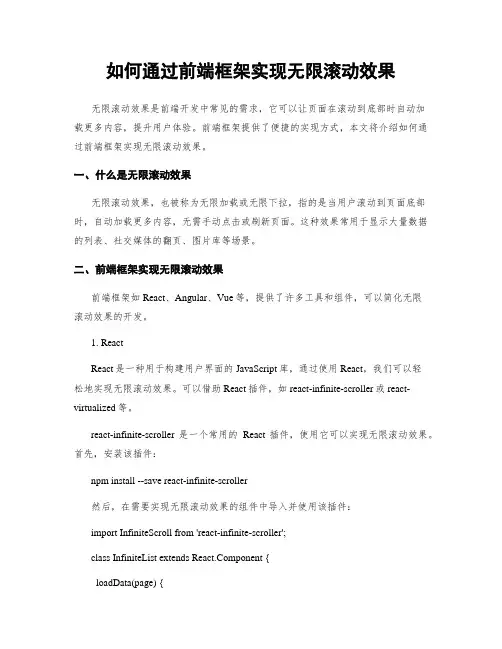
如何通过前端框架实现无限滚动效果无限滚动效果是前端开发中常见的需求,它可以让页面在滚动到底部时自动加载更多内容,提升用户体验。
前端框架提供了便捷的实现方式,本文将介绍如何通过前端框架实现无限滚动效果。
一、什么是无限滚动效果无限滚动效果,也被称为无限加载或无限下拉,指的是当用户滚动到页面底部时,自动加载更多内容,无需手动点击或刷新页面。
这种效果常用于显示大量数据的列表、社交媒体的翻页、图片库等场景。
二、前端框架实现无限滚动效果前端框架如React、Angular、Vue等,提供了许多工具和组件,可以简化无限滚动效果的开发。
1. ReactReact是一种用于构建用户界面的JavaScript库,通过使用React,我们可以轻松地实现无限滚动效果。
可以借助React插件,如react-infinite-scroller或react-virtualized等。
react-infinite-scroller是一个常用的React插件,使用它可以实现无限滚动效果。
首先,安装该插件:npm install --save react-infinite-scroller然后,在需要实现无限滚动效果的组件中导入并使用该插件:import InfiniteScroll from 'react-infinite-scroller';class InfiniteList extends ponent {loadData(page) {// 根据页码加载数据}render() {return (<InfiniteScrollloadMore={this.loadData}hasMore={true}loader={<div className="loader" key={0}>Loading ...</div>}>{/* 呈现数据列表 */}</InfiniteScroll>);}}在上述代码中,loadData函数用于根据页码加载数据,loadMore属性指定了加载更多数据时调用的函数,hasMore属性指示是否还有更多数据可加载,loader属性定义了加载数据时显示的加载器。
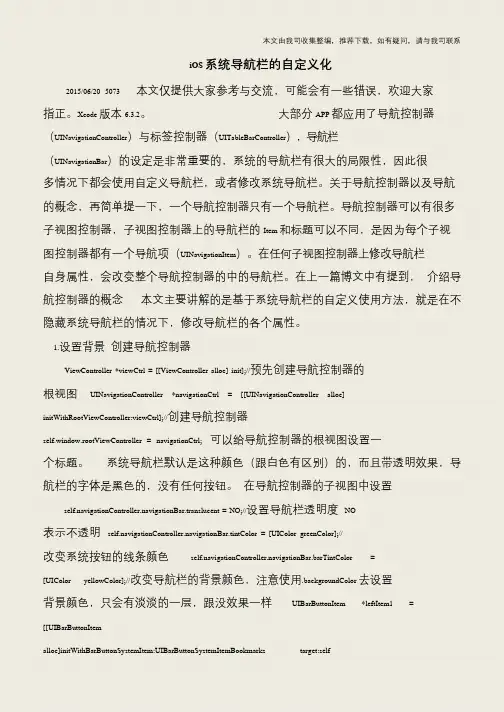
本文由我司收集整编,推荐下载,如有疑问,请与我司联系iOS 系统导航栏的自定义化2015/06/20 5073 本文仅提供大家参考与交流,可能会有一些错误,欢迎大家指正。
Xcode 版本6.3.2。
大部分APP 都应用了导航控制器(UINavigationController)与标签控制器(UITableBarController),导航栏(UINavigationBar)的设定是非常重要的,系统的导航栏有很大的局限性,因此很多情况下都会使用自定义导航栏,或者修改系统导航栏。
关于导航控制器以及导航的概念,再简单提一下,一个导航控制器只有一个导航栏。
导航控制器可以有很多子视图控制器,子视图控制器上的导航栏的Item 和标题可以不同,是因为每个子视图控制器都有一个导航项(UINavigationItem)。
在任何子视图控制器上修改导航栏自身属性,会改变整个导航控制器的中的导航栏。
在上一篇博文中有提到,介绍导航控制器的概念本文主要讲解的是基于系统导航栏的自定义使用方法,就是在不隐藏系统导航栏的情况下,修改导航栏的各个属性。
1.设置背景创建导航控制器ViewController *viewCtrl = [[ViewController alloc] init];//预先创建导航控制器的根视图UINavigationController *navigationCtrl = [[UINavigationController alloc] initWithRootViewController:viewCtrl];//创建导航控制器self.window.rootViewController = navigationCtrl; 可以给导航控制器的根视图设置一个标题。
系统导航栏默认是这种颜色(跟白色有区别)的,而且带透明效果,导航栏的字体是黑色的,没有任何按钮。
在导航控制器的子视图中设置self.navigationController.navigationBar.translucent = NO;//设置导航栏透明度NO 表示不透明self.navigationController.navigationBar.tintColor = [UIColor greenColor];// 改变系统按钮的线条颜色self.navigationController.navigationBar.barTintColor = [UIColor yellowColor];//改变导航栏的背景颜色,注意使用.backgroundColor 去设置背景颜色,只会有淡淡的一层,跟没效果一样UIBarButtonItem *leftItem1 = [[UIBarButtonItemalloc]initWithBarButtonSystemItem:UIBarButtonSystemItemBookmarks target:self。
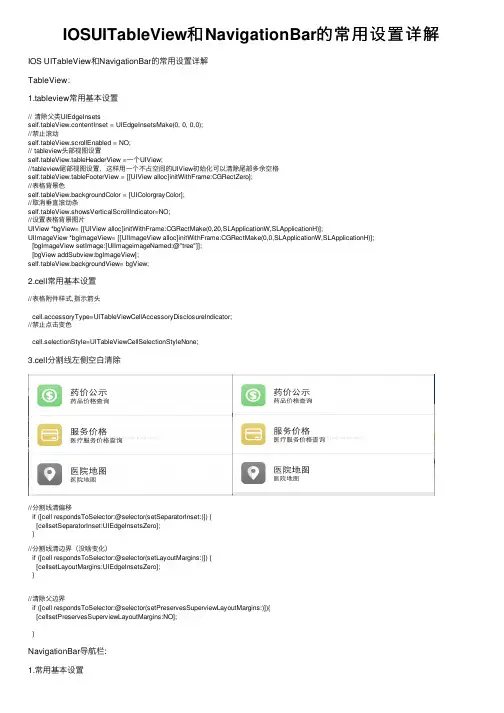
IOSUITableView和NavigationBar的常⽤设置详解IOS UITableView和NavigationBar的常⽤设置详解TableView:1.tableview常⽤基本设置// 清除⽗类UIEdgeInsetsself.tableView.contentInset = UIEdgeInsetsMake(0, 0, 0,0);//禁⽌滚动self.tableView.scrollEnabled = NO;// tableview头部视图设置self.tableView.tableHeaderView =⼀个UIView;//tableview尾部视图设置,这样⽤⼀个不占空间的UIView初始化可以清除尾部多余空格self.tableView.tableFooterView = [[UIView alloc]initWithFrame:CGRectZero];//表格背景⾊self.tableView.backgroundColor = [UIColorgrayColor];//取消垂直滚动条self.tableView.showsVerticalScrollIndicator=NO;//设置表格背景图⽚UIView *bgView= [[UIView alloc]initWithFrame:CGRectMake(0,20,SLApplicationW,SLApplicationH)];UIImageView *bgImageView= [[UIImageView alloc]initWithFrame:CGRectMake(0,0,SLApplicationW,SLApplicationH)];[bgImageView setImage:[UIImageimageNamed:@"tree"]];[bgView addSubview:bgImageView];self.tableView.backgroundView= bgView;2.cell常⽤基本设置//表格附件样式,指⽰箭头cell.accessoryType=UITableViewCellAccessoryDisclosureIndicator;//禁⽌点击变⾊cell.selectionStyle=UITableViewCellSelectionStyleNone;3.cell分割线左侧空⽩清除//分割线清偏移if ([cell respondsToSelector:@selector(setSeparatorInset:)]) {[cellsetSeparatorInset:UIEdgeInsetsZero];}//分割线清边界(没啥变化)if ([cell respondsToSelector:@selector(setLayoutMargins:)]) {[cellsetLayoutMargins:UIEdgeInsetsZero];}//清除⽗边界if ([cell respondsToSelector:@selector(setPreservesSuperviewLayoutMargins:)]){[cellsetPreservesSuperviewLayoutMargins:NO];}NavigationBar导航栏:1.常⽤基本设置self.title =@"标题";// 导航栏颜⾊self.navigationBar.barTintColor=[UIColor grayColor];// 导航栏⽂字颜⾊self.navigationBar.tintColor=[UIColor whiteColor];// 导航栏标题颜⾊NSMutableDictionary*textAttrs= [NSMutableDictionary dictionary];textAttrs[NSForegroundColorAttributeName] =[UIColor whiteColor];self.navigationBarsetTitleTextAttributes:textAttrs];//导航栏按钮1UIBarButtonItem*button1= [[UIBarButtonItem alloc]initWithBarButtonSystemItem:UIBarButtonSystemItemAddtarget:selfaction:@selector(function1)];//导航栏按钮2UIBarButtonItem*button2= [[UIBarButtonItem alloc]initWithBarButtonSystemItem:UIBarButtonSystemItemSearchtarget:selfaction:@selector(function2)]; //将按钮添加到导航栏右侧(可以添加多个)self.navigationItem.rightBarButtonItems=@[button1, button2];2.系统⾃带按钮枚举定义及样式解释如下:typedef NS_ENUM(NSInteger, UIBarButtonSystemItem) {UIBarButtonSystemItemDone, //Done英⽂字符UIBarButtonSystemItemCancel, //CancelUIBarButtonSystemItemEdit, //EditUIBarButtonSystemItemSave, //SaveUIBarButtonSystemItemAdd, //图标1(加号图标 )UIBarButtonSystemItemFlexibleSpace, //?空⽩UIBarButtonSystemItemFixedSpace, //?空⽩UIBarButtonSystemItemCompose, //图标2(写字板上⼀⽀笔写字的图标)UIBarButtonSystemItemReply, //图标3UIBarButtonSystemItemAction, //图标4UIBarButtonSystemItemOrganize, //图标5UIBarButtonSystemItemBookmarks, //<span style="font-family: Menlo;">图标6</span>UIBarButtonSystemItemSearch, //<span style="font-family: Menlo;">图标7</span>UIBarButtonSystemItemRefresh, //<span style="font-family: Menlo;">图标8</span>UIBarButtonSystemItemStop, //图标9UIBarButtonSystemItemCamera, //图标10UIBarButtonSystemItemTrash, //图标11UIBarButtonSystemItemPlay, //图标12UIBarButtonSystemItemPause, //图标13UIBarButtonSystemItemRewind, //图标14UIBarButtonSystemItemFastForward, //图标15UIBarButtonSystemItemUndo NS_ENUM_AVAILABLE_IOS(3_0), //RedoUIBarButtonSystemItemRedo NS_ENUM_AVAILABLE_IOS(3_0), //UndoUIBarButtonSystemItemPageCurl NS_ENUM_AVAILABLE_IOS(4_0), //?空⽩};感谢阅读,希望能帮助到⼤家,谢谢⼤家对本站的⽀持!。
iOS应用开发中导航栏按钮UIBarButtonItem的添加教程iOS应用开发中导航栏按钮UIBarButtonItem的添加教程这篇文章主要介绍了iOS应用开发中导航栏按钮UIBarButtonItem的添加教程,文中详细介绍了使用UINavigationController导航控制器添加的过程,需要的朋友可以参考下1、UINavigationController导航控制器如何使用UINavigationController可以翻译为导航控制器,在iOS里经常用到。
我们看看它的如何使用:下面的图显示了导航控制器的流程。
最左侧是根视图,当用户点击其中的General项时,General视图会滑入屏幕;当用户继续点击Auto-Lock项时,Auto-Lock视图将滑入屏幕。
相应地,在对象管理上,导航控制器使用了导航堆栈。
根视图控制器在堆栈最底层,接下来入栈的是General视图控制器和Auto-Lock视图控制器。
可以调用pushViewControllerAnimated:方法将视图控制器推入栈顶,也可以调用popViewControllerAnimated:方法将视图控制2、UINavigationController的结构组成看下图,UINavigationController有Navigationbar,NavigationView,Navigationtoobar等组成。
现在我们建立一个例子,看看如何使用UINavigationController3、新建一个项目命名为UINavigationControllerDemo,为了更好理解UINavigationController,我们选择EmptyApplication模板4、创建一个ViewController,命名为RootViewController:依次选择File——New——NewFile,默认勾上WithXIBforuserinterface.选择正确位置创建完成,这时项目里多了三个文件,分别是RootViewController.hRootViewController.mRootViewController.x ib文件。
iOS实现导航栏透明⽰例代码在最近⼀个项⽬中碰到这样⼀个场景,在被push进来的⼀个页⾯设置导航栏透明,且要求控制对tableview组的头视图进⾏悬停显⽰,nav随着tableview偏移量改变透明度,当然这样的需求确实不是什么难事,但是如果当前页⾯继续push⼀个不需要此类效果的页⾯,当在返回当前页⾯的时候就会出现⼀个坑,nav的展⽰很突兀,下⾯是直接上解决⽅法...ps:假设A页⾯为需要设置透明,B页⾯被Apush且不需要设置透明⾸先在需要设置导航栏透明的页⾯的viewDidload中写上self.title = @"Title";[self.navigationController.navigationBar setBackgroundImage:[UIImage new] forBarMetrics:UIBarMetricsDefault];self.navigationController.navigationBar.shadowImage = [UIImage new];self.barImageView = self.navigationController.navigationBar.subviews.firstObject;self.barImageView.alpha = 0;//设置状态栏[[UIApplication sharedApplication] setStatusBarStyle:UIStatusBarStyleLightContent];//设置标题颜⾊self.navigationController.navigationBar.titleTextAttributes = @{NSForegroundColorAttributeName : [UIColor clearColor]};在scrollViewDidScroll代理⽅法中-(void)scrollViewDidScroll:(UIScrollView *)scrollView {CGFloat offset = scrollView.contentOffset.y;//根据⾃⼰需要设置(136)的⼤⼩CGFloat alpha = offset / 136;_barImageView.alpha = alpha;//记录下当前的透明度,在返回当前页⾯时需要_alpha = alpha;[[NSUserDefaults standardUserDefaults] setObject:[NSNumber numberWithFloat:alpha] forKey:@"_alpha"];//设置标题的透明度self.navigationController.navigationBar.titleTextAttributes = @{NSForegroundColorAttributeName : [UIColor colorWithWhite:0 alpha:alpha]};}当前页的viewWillAppear, viewDidAppear, viewWillDisappear-(void)viewWillAppear:(BOOL)animated{[super viewWillAppear:animated];self.table.delegate = self;}-(void)viewDidAppear:(BOOL)animated {BOOL isGesturePop = [[[NSUserDefaults standardUserDefaults] objectForKey:@"isGesturePop"] boolValue];if (!isGesturePop) {_barImageView.alpha = _alpha;self.navigationController.navigationBar.titleTextAttributes = @{NSForegroundColorAttributeName : [UIColor colorWithWhite:0 alpha:_alpha]};}[super viewDidAppear:animated];}-(void)viewWillDisappear:(BOOL)animated{[super viewWillDisappear:animated];self.table.delegate = nil;self.navigationController.navigationBar.titleTextAttributes = @{NSForegroundColorAttributeName : [UIColor blackColor]};_barImageView.alpha = 1;[[NSUserDefaults standardUserDefaults] setObject:[NSNumber numberWithBool:NO] forKey:@"isGesturePop"];}那么在我们需要push的下⼀个页⾯需要什么操作呢,我们需要在这个页⾯显⽰正常的nav并且禁掉系统的⼿势pop,⾃⼰写⼀个pop⼿势,以⽅便我们拿到pop滑动时的偏移量,在做的时候使⽤了两个类,在最后会有源码贴出B.m 须遵守UIGestureRecognizerDelegate,并导⼊NavigationInteractiveTransition.h全局变量@property (nonatomic, strong) NavigationInteractiveTransition *navT;viewDidLoadself.navigationController.interactivePopGestureRecognizer.enabled = NO;UIGestureRecognizer *gesture = self.navigationController.interactivePopGestureRecognizer;gesture.enabled = NO;UIView *gestureView = gesture.view;UIPanGestureRecognizer *popRecognizer = [[UIPanGestureRecognizer alloc] init];popRecognizer.delegate = self;popRecognizer.maximumNumberOfTouches = 1;[gestureView addGestureRecognizer:popRecognizer];_navT = [[NavigationInteractiveTransition alloc] initWithViewController:self.navigationController];[popRecognizer addTarget:_navT action:@selector(handleControllerPop:)];UIGestureRecognizerDelegate 代理⽅法gestureRecognizerShouldBegin- (BOOL)gestureRecognizerShouldBegin:(UIGestureRecognizer *)gestureRecognizer {//记录当前是是否是通过⼿势滑动回去[[NSUserDefaults standardUserDefaults] setObject:[NSNumber numberWithBool:YES] forKey:@"isGesturePop"];/*** 这⾥有两个条件不允许⼿势执⾏,1、当前控制器为根控制器;2、如果这个push、pop动画正在执⾏(私有属性)*/return self.navigationController.viewControllers.count != 1 && ![[self.navigationController valueForKey:@"_isTransitioning"] boolValue];}需要依赖的两个类源码NavigationInteractiveTransition.h#import <UIKit/UIKit.h>@class UIViewController, UIPercentDrivenInteractiveTransition;@interface NavigationInteractiveTransition : NSObject <UINavigationControllerDelegate>- (instancetype)initWithViewController:(UIViewController *)vc;- (void)handleControllerPop:(UIPanGestureRecognizer *)recognizer;- (UIPercentDrivenInteractiveTransition *)interactivePopTransition;@endNavigationInteractiveTransition.m#import "NavigationInteractiveTransition.h"#import "PopAnimation.h"@interface NavigationInteractiveTransition ()@property (nonatomic, weak) UINavigationController *vc;@property (nonatomic, strong) UIPercentDrivenInteractiveTransition *interactivePopTransition;@property(nonatomic, strong) UIImageView *barImageView;@end@implementation NavigationInteractiveTransition- (instancetype)initWithViewController:(UIViewController *)vc{self = [super init];if (self) {self.vc = (UINavigationController *)vc;self.vc.delegate = self;}return self;}/*** 我们把⽤户的每次Pan⼿势操作作为⼀次pop动画的执⾏*/- (void)handleControllerPop:(UIPanGestureRecognizer *)recognizer {/*** interactivePopTransition就是我们说的⽅法2返回的对象,我们需要更新它的进度来控制Pop动画的流程,我们⽤⼿指在视图中的位置与视图宽度⽐例作为它的进度。
bootstrap导航栏模板Bootstrap是一个流行的前端框架,它为开发者提供了快速构建美观、响应式网页的工具和组件。
其中,导航栏是一个常用的控件,可以帮助用户方便地浏览网站的内容。
本文将介绍一些Bootstrap导航栏的模板,帮助你快速构建吸引人的网站。
1. 基本的导航栏基本的导航栏通常在页面的顶部,包含了网站的品牌、主要的菜单链接和一些附加元素(如搜索框和登录按钮)。
以下是一个基本的Bootstrap导航栏模板:```<nav class="navbar navbar-expand-lg navbar-light bg-light"><a class="navbar-brand" href="#">My Site</a><button class="navbar-toggler" type="button" data-toggle="collapse" data-target="#navbarNav" aria-controls="navbarNav" aria-expanded="false" aria-label="Toggle navigation"><span class="navbar-toggler-icon"></span></button><div class="collapse navbar-collapse" id="navbarNav"><ul class="navbar-nav"><li class="nav-item active"><a class="nav-link" href="#">Home <span class="sr-only">(current)</span></a></li><li class="nav-item"><a class="nav-link" href="#">About Us</a></li><li class="nav-item"><a class="nav-link" href="#">Products</a></li><li class="nav-item"><a class="nav-link" href="#">Contact Us</a></li></ul></div></nav>```在这个模板中,`navbar`类表示一个导航栏,`navbar-brand`类表示网站的品牌名称,`navbar-toggler`类是一个响应式的按钮,可以在小屏幕上切换菜单的显示和隐藏。
ios开发NavigationController的使用以上就是导航栏的效果,导航栏在项目中应用很广泛,需要熟练掌握。
新建项目,选择“Empty Application”,项目命名为:NavigationControllerTest新建一个UIViewController视图,命名为HomeViewConroller修改AppDeledate.h和AppDolegate.m源代码思路:将home"push到”navigationController中,再将navigationController.View 添加到window中// AppDelegate.m#import <UIKit/UIKit.h>@interface AppDelegate : UIResponder <UIApplicationDelegate>{UINavigationController *navigationController;}@property (strong, nonatomic) UIWindow *window;@end// AppDelegate.m#import"AppDelegate.h"#import"HomeViewController.h"@implementation AppDelegate@synthesize window = _window;- (BOOL)application:(UIApplication *)application didFinishLaunchingWithOptions:(NSDictionary *)launchOptions{self.window = [[[UIWindow alloc] initWithFrame:[[UIScreen mainScreen] bounds]] autorelease];self.window.backgroundColor = [UIColor whiteColor];navigationController = [[UINavigationController alloc] init];HomeViewController *home = [[HomeViewController alloc] init];home.title = @"备忘录";[navigationController pushViewController:home animated:NO];[self.window addSubview:navigationController.view];[home release];[self.window makeKeyAndVisible];return YES;}- (void)dealloc{[navigationController release];[_window release];[super dealloc];}@end效果如下图:上面的只是一个页面,下面新建一个UIViewController视图“SecondViewController”,使项目在两个页面间切换。
BootStrap学习(3)_导航菜单⼀、导航元素1.表格导航或标签以⼀个带有 class .nav 的⽆序列表开始。
添加 class .nav-tabs。
<!DOCTYPE html><html xmlns="/1999/xhtml"><head><meta http-equiv="Content-Type" content="text/html; charset=utf-8"/><title></title><link href="/libs/bootstrap/3.3.0/css/bootstrap.min.css" rel="stylesheet"/><script src="/libs/jquery/2.0.0/jquery.min.js"></script><script src="/libs/bootstrap/3.3.0/js/bootstrap.min.js"></script></head><body style="margin-top:20px;margin-left:20px;"><p>标签式的导航菜单</p><ul class="nav nav-tabs"><li class="active"><a href="#">Home</a></li><li><a href="#">SVN</a></li><li><a href="#">iOS</a></li><li><a href="#"></a></li><li><a href="#">Java</a></li><li><a href="#">PHP</a></li></ul></body></html>效果:2.胶囊式的导航菜单如果需要把标签改成胶囊的样式,只需要使⽤ class .nav-pills 代替 .nav-tabs 即可,其他的步骤与上⾯相同。
微信⼩程序使⽤weui构建搜索栏(searchbar)+导航(navbar)⾸先需要在lib⽬录中添加weui.wxss。
searchbar和navbar结合主要解决两者的层次问题,即搜索框输⼊时,下⽅的检索结果能够覆盖住navbar。
下⾯就开始发码啦:(1)wxml部分:<view class="page"><view><view class="page__bd"><view class="weui-search-bar"><view class="weui-search-bar__form"><view class="weui-search-bar__box"><icon class="weui-icon-search_in-box" type="search" size="14"></icon><input type="text" class="weui-search-bar__input" placeholder="搜索" value="{{inputVal}}" focus="{{inputShowed}}" bindinput="inputTyping"/><view class="weui-icon-clear" wx:if="{{inputVal.length > 0}}" bindtap="clearInput"><icon type="clear" size="14"></icon></view></view><label class="weui-search-bar__label" hidden="{{inputShowed}}" bindtap="showInput"><icon class="weui-icon-search" type="search" size="14"></icon><view class="weui-search-bar__text">搜索</view></label></view><view class="weui-search-bar__cancel-btn" hidden="{{!inputShowed}}" bindtap="hideInput">取消</view></view><view class="weui-cells searchbar-result searchBarCss" wx:if="{{inputVal.length > 0}}"><!-- 搜索列表 --><view class="weui-cell__bd" wx:for="{{list}}" wx:key="key"><navigator url="" class="weui-cell" hover-class="weui-cell_active" data-id='{{item.id}}' data-name='{{}}' bindtap='btn_name'><view class="weui-cell__bd"><view>{{}}</view></view></navigator></view></view></view></view><view class="page__bd"><view class="weui-tab"><view class="weui-navbar contentCss"><block wx:for="{{tabs}}" wx:key="*this"><view id="{{index}}" class="weui-navbar__item {{activeIndex == index ? 'weui-bar__item_on' : ''}}" bindtap="tabClick"><view class="weui-navbar__title">{{item}}</view></view></block><view class="weui-navbar__slider" style="left: {{sliderLeft}}px; transform: translateX({{sliderOffset}}px); -webkit-transform: translateX({{sliderOffset}}px);"></view> </view><view class="weui-tab__panel"><view class="weui-tab__content" hidden="{{activeIndex != 0}}"></view><view class="weui-tab__content" hidden="{{activeIndex != 1}}">选项⼆的内容</view></view></view></view></view>(2)js部分:(注意:注释部分主要是传递到后台做的相应的检索筛选结果,返回值是已经检索完成后的结果集合JsonArray格式)var sliderWidth = 96; // 需要设置slider的宽度,⽤于计算中间位置var app = getApp();Page({data: {tabs: ["能效看板", "设备看板"],activeIndex: 0,sliderOffset: 0,sliderLeft: 0,// 搜索框状态inputShowed: true,//显⽰结果view的状态viewShowed: false,// 搜索框值inputVal: "",//搜索渲染推荐数据list: [],},onLoad: function () {var that = this;wx.getSystemInfo({success: function (res) {that.setData({sliderLeft: (res.windowWidth / that.data.tabs.length - sliderWidth) / 2,sliderOffset: res.windowWidth / that.data.tabs.length * that.data.activeIndex });}});},tabClick: function (e) {this.setData({sliderOffset: e.currentTarget.offsetLeft,activeIndex: e.currentTarget.id});},showInput: function () {this.setData({inputShowed: true});},// 隐藏搜索框样式hideInput: function () {this.setData({inputVal: "",inputShowed: false});},// 清除搜索框值clearInput: function () {this.setData({inputVal: ""});},// 键盘抬起事件inputTyping: function (e) {console.log(e.detail.value)var that = this;if (e.detail.value == '') {return;}that.setData({viewShowed: false,inputVal: e.detail.value});/*wx.request({url: "*****",data: { "openid": "*****", "name": e.detail.value },method: 'GET',header: {'Content-type': 'application/json'},success: function (res) {that.setData({list: res.data})}});*///随便写⼏个单词作为检索后的结果集that.setData({list: [{"deviceId": "001","name": "abcaaaaaaaa"},{"deviceId": "002","name": "bcdaaaaaaaaa"},{"deviceId": "003","name": "cde"},{"deviceId": "004","name": "def"},{"deviceId": "005","name": "efg"}]})},// 获取选中推荐列表中的值btn_name: function (res) {var that = this;that.hideInput();console.log('name: ' + );},});(3)wxss部分:@import '../../lib/weui.wxss';page,.page,.page__bd{height: 100%; background-color: white;}.page__bd{padding-bottom: 0;}.weui-tab__content{padding-top: 60px;text-align: center;}.searchbar-result{margin-top: 0;font-size: 14px;}.searchbar-result:before{display: none;}.weui-cell{padding: 12px 15px 12px 35px;}.searchBarCss{position: fixed; width: 100%; background-color: white;z-index: 10; }.contentCss{width:100%; position:fixed;margin-top:100rpx;z-index:1;}。
【无线互联】iOS开发第三框架之导航栏篇XHYScrollingNavBarVC 和NavigationMenu-master集成。
XHYScrollingNavBarVC 和NavigationMenu-master集成
此框架结合了XHYScrollingNavBarVC 和 NavigationMenu-master,拥有如下功能和特点
1、支持UIWebView以及UITableView和scrollView。
2、当视图上拉时,导航栏隐藏,避免了导航栏占用了多余的空间。
3、当视图下拉时,导航栏显示,导航栏功能出现可以使用。
4、在导航栏标题改为了一个按钮,点击打开(或关闭)菜单按钮。
具体用法和实现。
注意:要设置self.navigationController.navigationBar.barTintColor 属性导航栏的颜色属性不会被失真。
2.将对应的scrollView、tableview、WebView:调用方法
[self followRollingScrollView:self.webView];//可以是scrollView或者tableview和WebView。
[self followRollingScrollView:_tabelView];
对应属性如下:
@property (weak, nonatomic) UIView *scrollView; //添加在控制器上的子视图
@property (retain,nonatomic)UIPanGestureRecognizer *panGesture; //平滑手指
@property (retain,nonatomic)UIView *overLay; //添加在导航栏上的覆盖视图
@property (assign,nonatomic)BOOL isHidden; //记录导航栏的隐藏
3.设置标题处的菜单按钮:将需要添加的菜单名字装在一个数组中赋值给self.items。
会自动生成相应按钮。
self.items =@[@"News",@"Top Articles", @"Messages",@"Account",@"Settings",@"Top Articles",@"Messages"];
4.实现点击相应菜单按钮的事件方法:- (void)didSelectItemAtIndex:(NSUInteger)index,index 为点击的第几个按钮的下表。
//导航栏的菜单按钮被点击了的事件方法
- (void)didSelectItemAtIndex:(NSUInteger)index{
NSLog(@"%d",index);
}
具体实现请看源代码......。